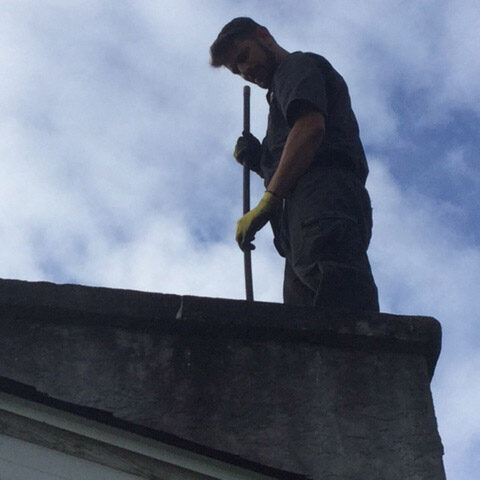Vital Chimney Maintenance San Jose Tips Every Property Owner Should Know
Vital Chimney Maintenance San Jose Tips Every Property Owner Should Know
Blog Article
Professional Tips for Effective Smokeshaft Upkeep You Required to Know
Chimneys offer as critical elements in numerous homes, offering warmth and comfort. From the relevance of routine inspections to risk-free functional practices, an extensive strategy to chimney upkeep is crucial.
Relevance of Regular Examinations
Routine assessments of smokeshafts are important for ensuring their security and functionality. Chimneys play a vital duty in airing vent out dangerous gases and maintaining appropriate air movement in a home. Over time, creosote accumulation, debris, and structural damages can take place within the chimney, positioning severe risks such as chimney fires or carbon monoxide gas leaks.
Throughout a chimney assessment, educated experts examine the condition of the chimney, trying to find any indicators of damage, blockages, or deterioration. They additionally examine the integrity of the flue, smokeshaft liner, and chimney cap to make certain whatever is in proper functioning order. By determining and resolving problems at an early stage, expensive repair work or prospective hazards can be stayed clear of.
Regular evaluations not only assist in maintaining the safety of the smokeshaft yet also add to its total efficiency. A tidy and well-maintained smokeshaft operates better, making certain correct air flow and lowering the risk of interior air contamination. Organizing annual smokeshaft inspections is a proactive procedure that home owners can take to protect their building and liked ones.
Cleaning Methods and Regularity
Preserving the safety and efficiency of a chimney involves not just routine evaluations but also applying ideal cleansing strategies and establishing the ideal frequency for cleansing. Smokeshafts should be cleansed by a specialist smokeshaft sweep at the very least annually, even if they are not frequently made use of. If the smokeshaft is utilized frequently, specifically with wood-burning ovens or fireplaces, it might call for more frequent cleansings to prevent the accumulation of creosote, an extremely combustible material that can lead to smokeshaft fires.
The cleaning process typically includes removing creosote, soot, and debris from the smokeshaft flue, smoke chamber, and firebox. Specialist smokeshaft brushes up use specialized vacuums, brushes, and tools to make sure extensive cleaning without developing a mess in the home. In addition, they check the chimney's framework for any kind of indications of damages or put on that might need repair work. House owners should never disregard chimney cleaning, as it is necessary for maintaining a practical and safe smokeshaft system - Chimney Maintenance San Jose. Routine cleanings not just minimize the danger of smokeshaft fires however also improve the smokeshaft's overall performance and durability.
Resolving Chimney Leaks

When attending to smokeshaft leakages, complete assessment and timely fixings are important to stop water damages and preserve the architectural integrity of the chimney. Leaks in a chimney can lead to severe problems such as mold development, wear and tear of the chimney structure, and also possible fire hazards. To efficiently attend to smokeshaft leakages, beginning by examining the smokeshaft cap, crown, blinking, and masonry for any indicators of damages or wear.
Recognizing Creosote Build-Up
To comprehend the prospective hazards of creosote accumulation in chimneys, it is important to acknowledge its formation procedure and effect on chimney efficiency. Creosote is a black or brownish tar-like substance that collects inside chimney systems when timber or fossil fuels are burned. As smoke climbs through the chimney, it cools and condenses, leading to the development of creosote, which abides by the smokeshaft walls.

Normal smokeshaft inspections and cleansings by a specialist chimney sweeper are vital in preventing creosote accumulation and making sure the risk-free operation of your smokeshaft system.
Safe Operation Practices
Carrying out proper safety procedures is crucial for the effective and protected procedure of chimney systems. Constantly guarantee that the chimney is expertly examined and cleansed frequently to get rid of any type of creosote accumulation, which can lead like this to smokeshaft fires.
Moreover, ensure to only melt skilled wood in your fire place, as damp or view it now green timber can create more creosote and trigger dangerous smokeshaft blockages. Lastly, never leave a fire unattended and constantly see to it the fire is entirely snuffed out prior to going to bed or leaving the house. By adhering to these secure operation techniques, you can delight in a cozy and comfy fire while guaranteeing the safety of your home and enjoyed ones.
Verdict
Finally, preserving your smokeshaft is important for guaranteeing its security and effectiveness. Normal inspections, correct cleansing methods, dealing with leakages, managing creosote build-up, and complying with secure procedure methods are essential aspects of chimney maintenance. By staying on top of these jobs, you can protect against possible risks and extend the life expectancy of your chimney. It is necessary to focus their website on chimney upkeep to maintain your home cozy and secure during the chillier months.
Over time, creosote build-up, debris, and structural damages can occur within the smokeshaft, posturing serious risks such as smokeshaft fires or carbon monoxide leakages.
If the smokeshaft is used on a regular basis, particularly with wood-burning cooktops or fire places, it might call for more regular cleanings to stop the build-up of creosote, a highly flammable substance that can lead to chimney fires. (Chimney Maintenance San Jose)
To understand the possible threats of creosote build-up in smokeshafts, it is essential to identify its formation process and impact on chimney efficiency. As smoke climbs with the chimney, it cools down and condenses, leading to the development of creosote, which adheres to the chimney wall surfaces.
Always make certain that the chimney is professionally evaluated and cleaned regularly to remove any type of creosote build-up, which can lead to chimney fires.
Report this page